By Dave Perlowski - Doctors tell us that a key factor for health maintenance is by taking many steps daily. If true, then MOPERC stainless steel hardware is the fittest hardware on the planet - and… it’s handmade in the MOPERC shop. Let me repeat, it’s handmade in the MOPERC shop. But before getting into the steps of the process let's talk about metal.
Stainless vs Chrome Plated
(Durable vs. bright'n shiny)
It's OK to admit it, but how many of us purchased our first congas from a music store and did so based on appearances, imagining how good we’d look playing our drums with stage lights beaming from that super-shiny chrome, dancing over the highly polished veneer shells. Yeah, that’d be great!
However, over time and with multiple load-ins, that attractive shine faded. Heck, the chrome may have even begun chipping, exposing the softer metal it had been concealing and resulting in a burning desire to spend more money for a drum upgrade. But that’s just the nature of chrome. It looks nice, for a while, but it dulls, it’s weaker and it’s prone to flaking.
That’s why MOPERC hardware is made of Stainless Steel. Sure, it costs more and it’s more difficult to work than its inferior chromed counterpart, but it’ll hold up without scratching for decades, looking the same as the day it was purchased. And isn’t that what is expected of an ultra-high quality instrument?
Now, there are some hand drum manufacturers that polish their stainless steel hardware to a high gloss. However, MOPERC’s preference is for the satin look obtained by a one-by-one treatment on a wire wheel. Same strength. Different look.
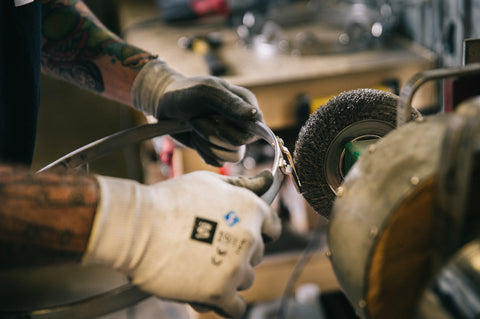
Metal shop
Metal shop, the class where kids get to weld, hammer and grind away, making trinkets for parents, is a favorite among students and those who cultivate a passion for metallurgy are keenly aware of the applications of the math and physics principles they suffered through in prior classes.
If we were to tour the current 600 square foot MOPERC metal department the first feature we would notice is its size, and as we walk through the shop, we might observe Michael and Yanik wearing leather blacksmith aprons, hard at work shaping and grinding pieces of stainless into crowns, hooks and side plates. But at any given time, we might find any of the MOPERC artisans working metal because each employee excels at every aspect of the MOPERC process to ensure fluidity.

Aside from the enormity of the department, though, the most striking aspect is the equipment. Each tool, designed for a singular function, performs its own critical step toward making hardware for world class hand drums, and when the hydraulic presses, anvils, vices, TIG welder, ring roller, dyes, punches, metal saws, wire wheel brushes, band sander and grinders are humming, banging and sparking, it’s a mesmerizing cacophony.
More Than Meets The Eye
Those of us who play, rarely consider our drum’s hardware to be much more than a crown, lugs, side plates, nuts and washers and as long as they work well enough to tune the instrument, we don’t give it another thought. But there’s more. Much more:
Stainless steel side plates;
THE PLATE, ITSELF
There is no mistaking the MOPERC stainless steel side plate with the side plate of any other manufacturer. Its unique design is laser cut locally to ensure uniformity. In the MOPERC shop, it is sanded smooth, screw holes are countersunk and then (here’s the part no one considers) a hydraulic press is used to form the curve that allows the plate to sit perfectly flat against the shell.
SCREW IT!
So now, it would be good to discuss a basic principle of physics. That being: the greatest reinforcement should be placed at the area of greatest stress, and whether you describe the MOPERC side plates as looking like an “A” or an inverted “V” it’s a demonstration of physics at work protecting the integrity of every MOPERC drum. When a conga drum is brought into tune, the greatest tension on the side plate occurs at the bottom where the tendency is for the side plate to pull upward and away from the shell. That’s why MOPERC attaches two screws at that point, rather than at the top, where it would be less effective.
Another important point that often goes unnoticed is that the screws attaching MOPERC side plates to the shell are like some people’s concept of the earth - flat, and because each hole is machined to eighty-two degrees, those flat screws sit flush with the side plates, creating maximum space in which to turn a wrench. By comparison, drums from manufacturers that attach side plates with round head screws limit the range of motion for each wrench turn and sometimes preclude the use of hand-ratchets and other tools designed to make tuning easy. By using countersunk flat screws, MOPERC players spend less time tuning and more time playing.

THE LOOP
The loop, you know, that thing attached to the side plate that keeps the tuning lug in place? Well, the MOPERC loop design is a pattern that Ray Bereck (Skin On Skin) passed along to Michel when he first began making drums. A short piece of flat bar is cut and 3 different dyes are used to bend it into shape. The straight part is designed to fit into the plate slot and it is then TIG welded from behind and again in front to attain maximum durability, resulting in an extremely solid side plate that will never break or bend.
If you’re counting steps, that’s ten for just a single side plate. Sixty for each drum! The result is worth it, though, because even though it’s the single-most time consuming part of the entire process, MOPERC stainless steel side plates are strong, lay flat, have plenty of tuning room and are designed to make life easier when changing skins.
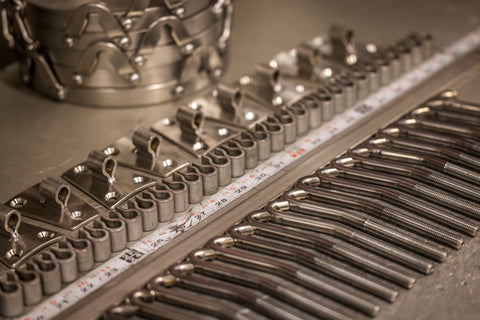
THE CROWN
Stainless steel crowns;
Unlike stocking caps and tube socks, conga crowns are not “one-size-fits-all,” so it’s a good thing that Francis and Michel paid close attention in their geometry classes when the concept of Pi was explained relative to a circle’s area and circumference. MOPERC congas range from 9” to 14” and that constant value of 3.1416 plays a key role every time a stainless steel crown or steel ¼ round flesh hoop is made.
Once all the calculations are made, 3/16 thick flat bars are cut from raw stainless steel to the right length for each drum. It’s important that a crown fits perfectly.
The flat edges of the bar are ground and sanded for a round and comfortable shape and in the middle of where each “V” will be placed, divisions where the MOPERC logo will be punched are drawn. Then, with the help of a conventional hand roller and anvil, the flat steel bar is rolled and bent until perfectly round. and TIG welded closed. The MOPERC “look” is then attained by brushing, rather than by polishing.
These procedures are slightly modified for those who prefer to use the tucked Fiberskyn by REMO.
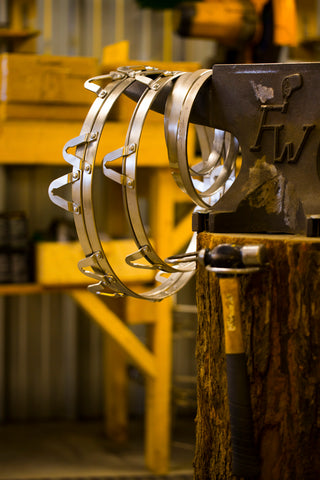
The V
Like MOPERC side plates, the “V’s” are laser cut locally, and when they arrive, they are rough and flat so they must be sanded smooth and bent to properly fit the crown (yep, more geometry). Incidentally, because MOPERC’s attention to detail is so meticulous, the bottom of the “V” where the lug attaches, is not rounded, like most others, but comes to a point, preventing the lug from turning while tuning.
After observing Marcus Ruiz’ technique of cold pressing stainless steel rivets, the MOPERC process of hand-hammering was simplified once a custom dye was installed. Now, after twelve holes are drilled in the crown, the V’s are attached, pressed and then hand hammered to assure a 100% solid bond . No welding in that process and once complete, the completed crown is given a final brushing and cleaning and it’s ready to go.
LUGS
Lugs begin life in the MOPERC shop as twelve foot ⅜” ( 5/16” for bongos and bingbas) round stainless steel bars and once cut to length, they’re sent to the metal lathe for threading. Once done, the straight rods are plied a couple times using different dyes on the old MOPERC press that has made nearly 10,000 lugs over the last 5 years. The point is then ground to a flat surface that won’t touch the drum shell. The lug is brushed, cleaned and ready to install.
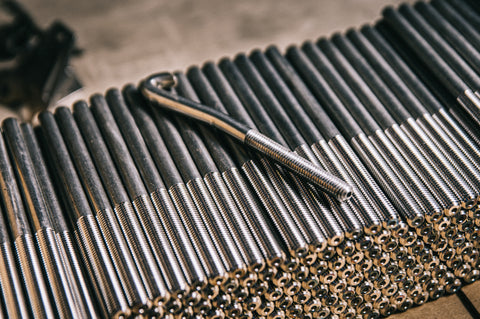
BANDS
Do MOPERC drums need them? Nope. Do they look good? Oh, yeah. Are MOPERC bands functional? Yep. Wait! What?! Yes, MOPERC bands ARE indeed functional because they are made to expand or contract with a shell as changes in climate occur.
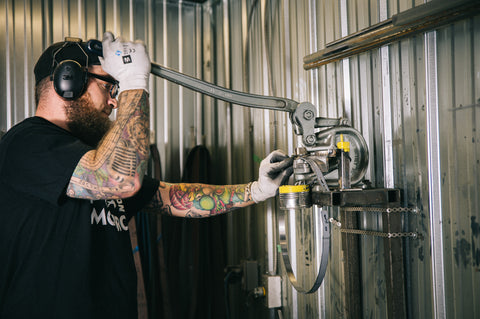
Like every other piece of MOPERC hardware, a lot of steps go into making a simple band. After stainless strips are cut to the right length, they are sanded and the corners are rounded to give a nice look on the instrument. Holes are marked to the right place, and then an offset is pressed on the end so it will sit down properly when overlapping on the drum. After the strip is hand-rolled, the holes are then punched with a wide point to provide room for adjustment, if needed in the future.
Whew!!! That’s a LOT of steps to make just the hardware for one set of congas, but top-quality hardware is important when building the best drums on the market. And because each piece is made one at a time, quality control is constant. If a piece is found to be flawed, it gets discarded - something that likely does not occur in mass-production operations. It’s attention to detail that makes the MOPERC difference and it’s that difference that keeps MOPERC drums looking good and sounding pure well into the future.

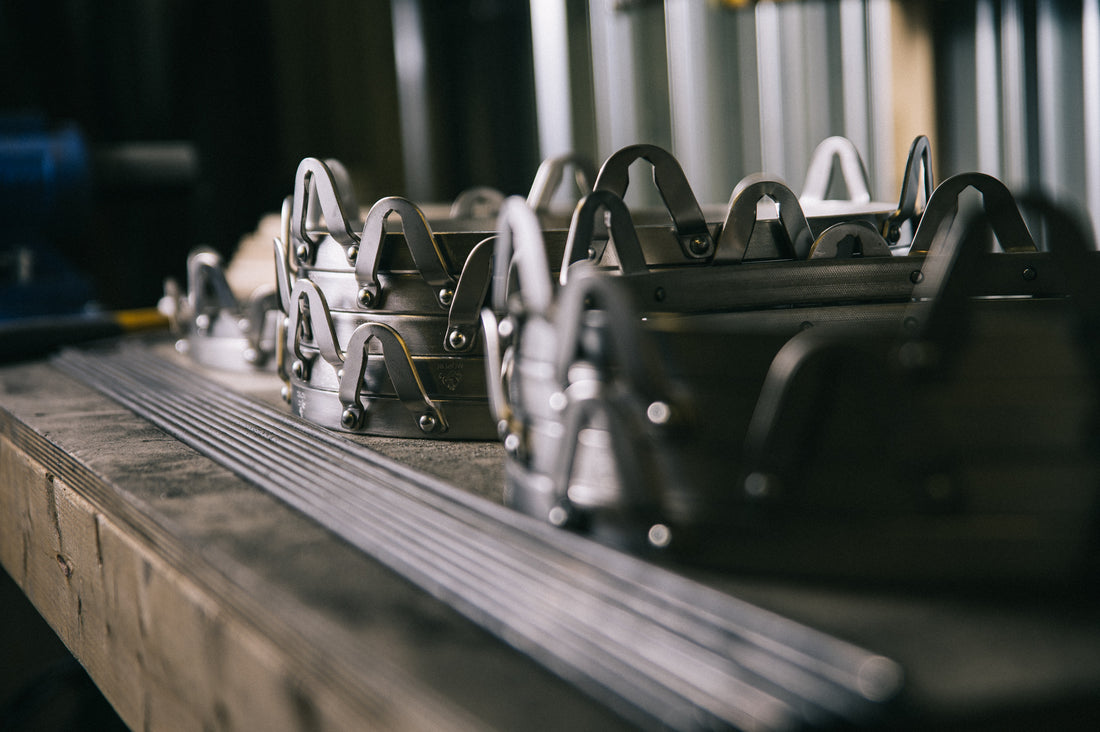
3 comments
Do you sell mounting lugs, looking for 6 7” ones for mounting new skins
Do you also have quality skins and rings for mounting ? If so, what types and thicknesses? Thanks so much..
There is a typo in the Blog piece on hardware. The owner of Skin on Skin was Jay, not Ray. Change “Ray” to “Jay” in the following text:
“ THE LOOP
The loop, you know, that thing attached to the side plate that keeps the tuning lug in place? Well, the MOPERC loop design is a pattern that Ray Bereck (Skin On Skin) passed along to Michel when he first began making drums….”